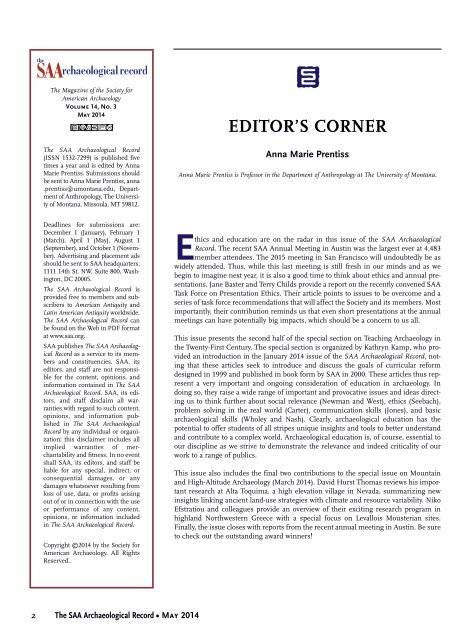May2014
May2014
May2014
Create successful ePaper yourself
Turn your PDF publications into a flip-book with our unique Google optimized e-Paper software.
theSAA archaeologicalrecordThe Magazine of the Society forAmerican ArchaeologyVolume 14, No. 3May 2014The SAA Archaeological Record(ISSN 1532-7299) is published fivetimes a year and is edited by AnnaMarie Prentiss. Submissions shouldbe sent to Anna Marie Prentiss, anna.prentiss@umontana.edu, Departmentof Anthropology, The Universityof Montana, Missoula, MT 59812.EDITOR’S CORNERAnna Marie PrentissAnna Marie Prentiss is Professor in the Department of Anthropology at The University of Montana.Deadlines for submissions are:December 1 (January), February 1(March), April 1 (May), August 1(September), and October 1 (November).Advertising and placement adsshould be sent to SAA headquarters,1111 14th St. NW, Suite 800, Washington,DC 20005.The SAA Archaeological Record isprovided free to members and subscribersto American Antiquity andLatin American Antiquity worldwide.The SAA Archaeological Record canbe found on the Web in PDF formatat www.saa.org.SAA publishes The SAA ArchaeologicalRecord as a service to its membersand constituencies. SAA, itseditors, and staff are not responsiblefor the content, opinions, andinformation contained in The SAAArchaeological Record. SAA, its editors,and staff disclaim all warrantieswith regard to such content,opinions, and information publishedin The SAA ArchaeologicalRecord by any individual or organization;this disclaimer includes allimplied warranties of merchantabilityand fitness. In no eventshall SAA, its editors, and staff beliable for any special, indirect, orconsequential damages, or anydamages whatsoever resulting fromloss of use, data, or profits arisingout of or in connection with the useor performance of any content,opinions, or information includedin The SAA Archaeological Record.Copyright ©2014 by the Society forAmerican Archaeology. All RightsReserved.Ethics and education are on the radar in this issue of the SAA ArchaeologicalRecord. The recent SAA Annual Meeting in Austin was the largest ever at 4,483member attendees. The 2015 meeting in San Francisco will undoubtedly be aswidely attended. Thus, while this last meeting is still fresh in our minds and as webegin to imagine next year, it is also a good time to think about ethics and annual presentations.Jane Baxter and Terry Childs provide a report on the recently convened SAATask Force on Presentation Ethics. Their article points to issues to be overcome and aseries of task force recommendations that will affect the Society and its members. Mostimportantly, their contribution reminds us that even short presentations at the annualmeetings can have potentially big impacts, which should be a concern to us all.This issue presents the second half of the special section on Teaching Archaeology inthe Twenty-First Century. The special section is organized by Kathryn Kamp, who providedan introduction in the January 2014 issue of the SAA Archaeological Record, notingthat these articles seek to introduce and discuss the goals of curricular reformdesigned in 1999 and published in book form by SAA in 2000. These articles thus representa very important and ongoing consideration of education in archaeology. Indoing so, they raise a wide range of important and provocative issues and ideas directingus to think further about social relevance (Newman and West), ethics (Seebach),problem solving in the real world (Carter), communication skills (Jones), and basicarchaeological skills (Wholey and Nash). Clearly, archaeological education has thepotential to offer students of all stripes unique insights and tools to better understandand contribute to a complex world. Archaeological education is, of course, essential toour discipline as we strive to demonstrate the relevance and indeed criticality of ourwork to a range of publics.This issue also includes the final two contributions to the special issue on Mountainand High-Altitude Archaeology (March 2014). David Hurst Thomas reviews his importantresearch at Alta Toquima, a high elevation village in Nevada, summarizing newinsights linking ancient land-use strategies with climate and resource variability. NikoEfstratiou and colleagues provide an overview of their exciting research program inhighland Northwestern Greece with a special focus on Levallois Mousterian sites.Finally, the issue closes with reports from the recent annual meeting in Austin. Be sureto check out the outstanding award winners!2 The SAA Archaeological Record • May 2014




